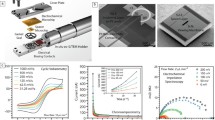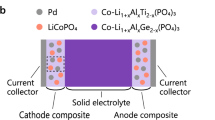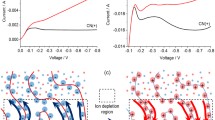Abstract
In situ transmission electron microscopy (TEM) was carried out to investigate the dynamics of resistance switching in a solid electrolyte, Cu-Ge-S. By applying voltage to Pt-Ir/Cu-Ge-S/Pt-Ir, where Pt-Ir constituted the electrodes, a deposit containing conductive filaments composed mainly of Cu was formed around the cathode. As voltage continued to be applied, the deposit grew and finally narrow conductive filaments made contact with the anode. This corresponded to resistance switching from high- to low-resistance states (HRS and LRS). By alternating the voltage, the deposit contracted toward the cathode and detached from the anode. The resistance immediately changed from LRS to HRS. By applying voltage, the deposit containing Cu-based filaments grew and shrank, and resistance switching occurred at the electrolyte-anode interface. This conductive filament-formation model, which was recently reported, was experimentally confirmed with TEM through dynamic observations of the deposit-containing filaments.











Similar content being viewed by others
REFERENCES
S.Q. Liu, N.J. Wu, and A. Ignatiev: Electric-pulse-induced reversible resistance change effect in magnetoresistive films. Appl. Phys. Lett. 76, 2749 (2000).
A. Sawa, T. Fujii, M. Kawasaki, and Y. Tokuda: Hysteretic current-voltage characteristics and resistance switching at a rectifying Ti/Pr0.7Ca0.3MnO3 interface. Appl. Phys. Lett. 85, 4073 (2004).
H. Kaji, H. Kondo, T. Fujii, M. Arita, and Y. Takahashi: Effect of electrode and interface oxide on the property of ReRAM composed of Pr0.7Ca0.3MnO3. IOP Conf. Ser. Mater. Sci. Eng. 8, 012032 (2010).
I.G. Baek, M.S. Lee, S. Seo, M.J. Lee, D.H. Seo, D.-S. Suh, J.C. Park, S.O. Park, H.S. Kim, I.K. Yoo, U-In Chung, and J.T. Moon: Highly scalable non-volataile resistive memory using simple binary oxide driven by asymmetric unipolar voltage pulses. Tech. Dig. Int. Electron Devices Meet. (San Francisco, CA, 2004), pp. 587–590.
A. Sawa: Resistive switching in transition metal oxides. Mater. Today 11, 28 (2008).
G.-S. Park, X.-S. Li, D.-C. Kim, R.-J. Jung, M.-J. Lee, and S. Seo: Observation of electric-field induced Ni filament channels in polycrystalline NiOx film. Appl. Phys. Lett. 91, 222103 (2007).
H. Kondo, H. Kaji, T. Fujii, K. Hamada, M. Arita, and Y. Takahashi: The influence of annealing temperature on ReRAM characteristics of metal/NiO/metal structure. IOP Conf. Ser. Mater. Sci. Eng. 8, 012034 (2010).
C. Yoshida, K. Tsunoda, H. Noshiro, and Y. Sugiyama: High speed resistive switching in Pt/TiO2/TiN film for nonvolatile memory application. Appl. Phys. Lett. 91, 223510 (2007).
K. Fujiwara, T. Nemoto, M.J. Rozenberg, Y. Nakamura, and H. Takagi: Resistance switching and formation of a conductive bridge in metal/binary oxide/metal structure for memory devices. Jpn. J. Appl. Phys. 47, 6266 (2008).
M.N. Kozicki, M. Park, and M. Mitkova: Nanoscale memory elements based on solid-state electrolytes. IEEE. Trans. Nanotechnol. 4, 331 (2005).
M.N. Kozicki, M. Balakrishnan, C. Gopalan, C. Ratnakumar, and M. Mitkova: Programmable metallization cell memory based on Ag-Ge-S and Cu-Ge-S electrolytes. Proc. IEEE Non-Volatile Memory Technol. Symp. (Dallas, TX, 2005), pp. 83–89.
M.N. Kozicki, C. Ratnakumar, and M. Mitkova: Electrodeposit formation in solid electrolytes. Proc. IEEE Non-Volatile Memory Technol. Symp. San Mateo, CA, 2006), pp. 111–115.
D. Kamalanathan, U. Russo, D. Ielmini, and M.N. Kozicki: Voltage-driven on-off transition and tradeoff with program and erase current in programmable metallization cell (PMC) memory. IEEE Electron Device Lett. 30, 533 (2009).
T. Sakamoto, H. Sunamura, H. Kawaura, T. Hasegawa, T. Nakayama, and M. Aono: Nanometer-scale switching using copper sulfide. Appl. Phys. Lett. 82, 3032 (2003).
K. Terabe, T. Hasegawa, T. Nakayama, and M. Aono: Quantized conductance atomic switch. Nature 433, 47 (2005).
Z. Xu, Y. Bando, W. Wang, X. Bai, and D. Golberg: Real-time in situ HRTEM-resolved resistance switching of Ag2S nanoscale ionic conductor. ACS Nano 4, 2515 (2010).
S. Tsui, A. Baikalov, J. Cmaidalka, Y.Y. Sun, Y.Q. Wang, Y.Y. Xue, C.W. Chu, L. Chen, and A.J. Jacobson: Field-induced resistive switching in metal-oxide interfaces. Appl. Phys. Lett. 85, 317 (2004).
Y.B. Nian, J. Srozier, N.J. Wu, X. Chen, and A. Ignatiev: Evidence for an oxygen diffusion model for the electric pulse induced resistance change effect in transition-metal oxides. Phys. Rev. Lett. 98, 146403 (2007).
R. Waser and M. Aono: Nanoionics-based resistive switching memories. Nat Mater. 6, 833 (2007).
R. Waser, R. Dittmann, G. Staikov, and K. Szot: Redox-based resistive switching memories—nanoionic mechanisms, prospects, and challenges. Adv. Mater. 21, 2632 (2009).
Y. Tsujii, T. Sakamoto, N. Banno, H. Hada, and M. Aono: Off-state and turn-on characteristics of solid electrolyte switch. Appl. Phys. Lett. 96, 023504 (2010).
T. Sakamoto, K. Lister, N. Banno, T. Hasegawa, K. Terabe, and M. Aono: Electronic transport in Ta2O5 resistive switch. Appl. Phys. Lett. 91, 092110 (2007).
C. Schindler, G. Staikov, and R. Waiser: Electrode kinetics of Cu-SiO2-based resistive switching cells: Overcoming the voltage-time dilemma of electrochemical metallization memories. Appl. Phys. Lett. 94, 072109 (2009).
M. Tada, T. Sakamoto, N. Banno, M. Aono, H. Hada, N. Kasai: Nonvolatile crossbar switch using TiOx/TaSiOy solid electrolyte. IEEE Trans. Electron Devices 57, 1987 (2010).
K. Aratani, K. Ohba, T. Mizuguchi, S. Yasuda, T. Shiimoto, T. Tsushima, T. Sone, K. Endo, A. Kouchiyama, S. Sasaki, A. Maesaka, N. Yamada, and H. Narisawa: A novel resistance memory with high scalability and nanosecond switching. Tech. Dig. Int. Electron Devices Meet. Washington, D.C., 2007), pp. 783–786.
R. Yasuhara, K. Fujiwara, K. Horiba, H. Kumigashira, M. Kotsugi, M. Oshima, and H. Takagi: Inhomogeneous chemical states in resistance-switching devices with a planar-type Pt/CuO/Pt structure. Appl. Phys. Lett. 95, 012110 (2009).
H. Ohnishi, Y. Kondo, and K. Takayanagi: Quantized conductance through individual rows of suspended gold atoms. Nature 395, 780 (1998).
T. Kizuka, S. Umehara, and S. Fujiwara: Metal-insulator transition in stable one-dimensional arrangements of single gold atoms. Jpn. J. Appl. Phys. 40, L71 (2001).
M. Arita, Y. Okubo, K. Hamada, Y. Takahashi: Tunnel current measurement of MgO and MgO/Fe/MgO nanoregions during TEM observation. Superlattices Microstruct 44, 633 (2008).
C.H. Jooss, J. Hoffmann, J. Fladerer, M. Ehrhardt, T. Beetz, L. Wu, and Y. Zhu: Electric pulse induced resistance change effect in manganites due to polaron localization at the metal-oxide interfacial region. Phys. Rev. B 77, 132409 (2008).
T. Fujii, H. Kaji, H. Kondo, K. Hamada, M. Arita, and Y. Takahashi: I-V hysteresis of Pr0.7Ca0.3MnO3 during TEM observation. IOP Conf. Ser. Mater. Sci. Eng. 8, 012033 (2010).
D.-H. Kwon, K.M. Kim, J.H. Jang, J.M. Jeon, M.H. Lee, G.H. Kim, X.-S. Li, G.-S. Park, B. Lee, S. Han, M. Kim, and C.S. Hwang: Atomic structure of conducting nanofilaments in TiO2 resistive switching memory. Nat. Nanotechnol. 5, 148 (2010).
T. Fujii, M. Arita, K. Hamada, H. Kondo, H. Kaji, Y. Takahashi, M. Moniwa, I. Fujiwara, T. Yamaguchi, M. Aoki, Y. Maeno, T. Kobayashi, and M. Yoshimaru: I-V measurement of NiO nanoregion during observation by transmission electron microscopy. J. Appl. Phys. 109, 053702 (2011).
D. Cha, S.J. Ahn, S.Y. Park, H. Horii, D.H. Kim, Y.K. Kim, S.O. Park, U.I. Jung, M.J. Kim, and J. Kim: A direct observation on the structure evolution of memory-switching phenomena using in-situ TEM. Dig. Tech. Symp. VLSI Technol. Kyoto, Japan, 2009), pp. 204–205.
P. Gao, Z. Wang, W. Fu, Z. Liao, K. Liu, W. Wang, X. Bai, and E. Wang: In situ TEM studies of oxygen vacancy migration for electrically induced resistance change effect in cerium oxides. Micron 41, 301 (2010).
R. Hirose, M. Arita, K. Hamada, and Y. Takahashi: In situ conductance measurement of a limited number of nanoparticles during transmission electron microscopy observation. Jpn. J. Appl. Phys. 44, L790 (2005).
T. Fujii, M. Arita, Y. Takahashi, and I. Fujiwara: In situ transmission electron microscopy analysis of conductive filament during solid electrolyte resistance switching. Appl. Phys. Lett. 98, 212104 (2011).
R. Hirose, M. Arita, K. Hamada, and A. Okada: Tip production technique to form ferromagnetic nanodots. Mater. Sci. Eng. C 23, 927 (2003).
T. Hamada and F.E. Fujita: Interference function of crystalline embryo model of amorphous metals 1. Jpn. J. Appl. Phys. 21, 981 (1982).
ACKNOWLEDGMENTS
We wish to thank Mr. S. Yasuda (Sony Corporation) for his collaboration in fabricating the devices, and Drs. M. Moniwa, T. Yamaguchi, and M. Yoshimaru (Semiconductor Technology Academic Research Center) for the productive discussions we had with them. We are grateful to Dr. K. Hamada for developing our piezo TEM holder. The TEM-EDX analyses were performed at the Center for Advanced Research of Energy and Materials (CAREM) of Hokkaido University with the kind support of Prof. N. Sakaguchi, to whom also we are grateful. Our research was partially supported by a grant from the Global COE Program, “Center for Next-Generation Information Technology Based on Knowledge Discovery and Knowledge Federation,” made available by The Ministry of Education, Culture, Sports, Science and Technology (MEXT) of Japan, and by Grants-in Aid for Scientific Research (KAKENHI) from MEXT and the Japan Society for the Promotion of Science (JSPS) (Grant Nos. 21560681 and 22240022)
Author information
Authors and Affiliations
Corresponding author
Rights and permissions
About this article
Cite this article
Fujii, T., Arita, M., Takahashi, Y. et al. Analysis of resistance switching and conductive filaments inside Cu-Ge-S using in situ transmission electron microscopy. Journal of Materials Research 27, 886–896 (2012). https://doi.org/10.1557/jmr.2011.437
Received:
Accepted:
Published:
Issue Date:
DOI: https://doi.org/10.1557/jmr.2011.437




